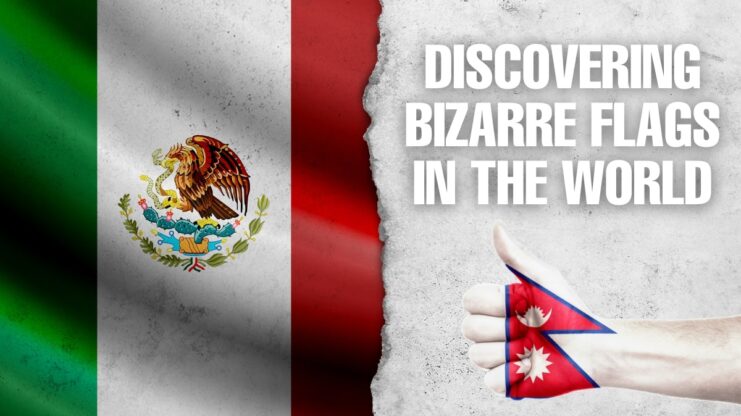In an increasingly globalized world, flags have become particularly important in national identity. They are a symbol of national pride and a marker of national independence and sovereignty. Countries will usually design their flags to carry elements of the national history, culture, or political stance of their country. Many of them feature the colors associated with a nation, while some include specific symbols or designs to represent their country’s history or culture.
However, there are some countries around the world that have decided to fly flags with particularly strange designs. From shapes that leave you perplexed, to blatant assertions which defy international rules; some bizarre flags from around the world aim to make a statement beyond just being unique and eye-catching. This article will explore some of the weirdest flag creations from countries around the globe in an effort to uncover what inspired such creations and how they fit with that country’s history and culture.
Flags of the World
They are a visual representation of the history and culture of different countries. They are a source of pride and patriotism for many and often hold deep meaning to those who live in that country.
Let’s take a look at some of the most bizarre flags from around the world.
1. Nepal
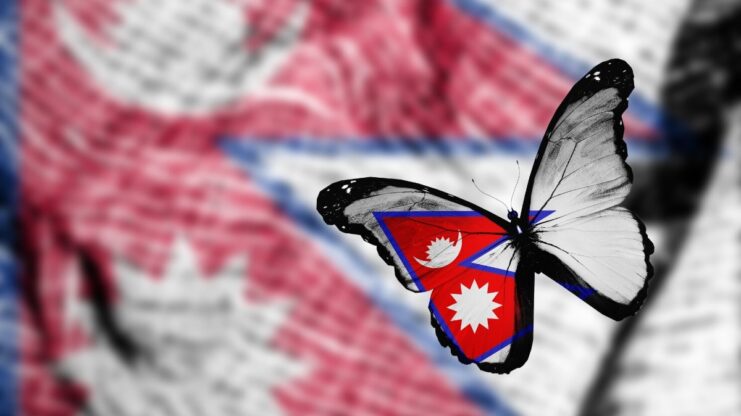
The emblems on it represent the country’s cultural and religious heritage. The moon on the upper left is believed to be a representation of grace and peace, while the sun symbolizes fortitude and strength. The crimson area in the center triangle signifies boldness and bravery by evoking imagery of a government filled with courage, power, generosity, and dedication.
This rectangular-shaped flag is unique in its dimensions which are twice as long as they are high – it measures 8:4 horizontally. Historically this particular ratio has been used on flags around the world since at least 700 AD — suggested to be due to its use for easy construction on ancient looms that were too small for rectangular designs other than 8:4. It is said that upon his coronation in 1768, King Prithivi Narayan Shah designed this particular pattern to honor his ancestors’ bravery during battle.
The flag was officially adopted on December 16th, 1962 when Nepal changed from being a monarchy to a republic but it has been partially or fully incorporated into nine different flags used throughout Nepal’s history over the past 300+ years. Its use has become increasingly popular in recent years both at home and abroad as Nepalese immigrants around the world — particularly those living in India — proudly display their heritage by hoisting it at protests or rallies celebrating Nepalese culture or independence initiatives.
2. North Korea

The flag of the Democratic People’s Republic of Korea (DPRK) is characterized by a red field with a white disk, featuring a five-pointed red star above a blue horizontal line in the center. This design was inspired by the Korean Worker’s Party Flag and was adopted in 1948.
The design of the white disk symbolizes spirit and unity, while the blue band running across it represents gravity, balance, and peace. The star symbolizes socialism, progress, and national dignity. The scarlet color stands for Marxism-Leninism and the revolutionary traditions of the people who devoted their lives to building an independent nation.
3. Mexico
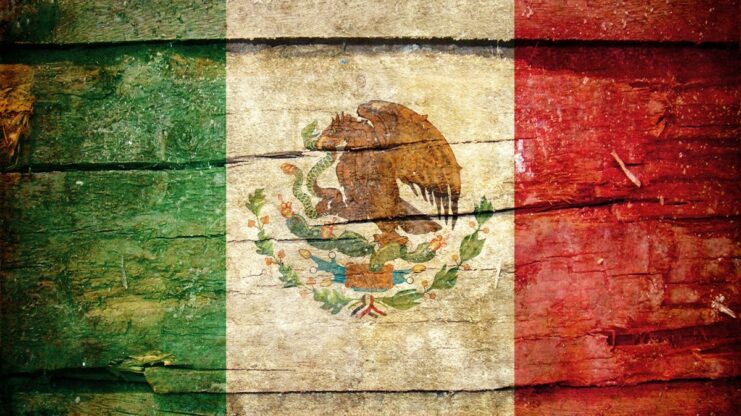
The current one has been in use since February 24th, 1968, when the Congress of Mexico approved it. The red, white, and green vertical tricolor of the flag is inspired by the national liberties movement in the 19th century. It is said to have been based on a pre-Hispanic flag that was used by the Aztecs during their struggles against the Spanish conquest.
At the center of it lies an eagle perched atop a cactus while consuming a serpent. This symbol dates all the way back to Aztec mythology and legends, which were documented by conquistadors in 1519 during their arrival at Tenochtitlan (modern-day Mexico City). According to these stories, Huitzilopochtli (the Aztec patron god) instructed them to find their settlement where they saw an eagle eating a snake while perched atop a cactus growing out of lake Texcoco. This scene appears on many Mexican government seals today.
The meaning attributed to each element of this iconic symbol depends on who you ask; however, it’s generally agreed that it is meant to represent: The eagle – strength and bravery; The cactus – resilience and accuracy; The snake – eternity and knowledge; The colors – white for religion, red for union & war, green for hope and joy; The Coat of Arms – Union and Justice for all Mexicans.
4. India
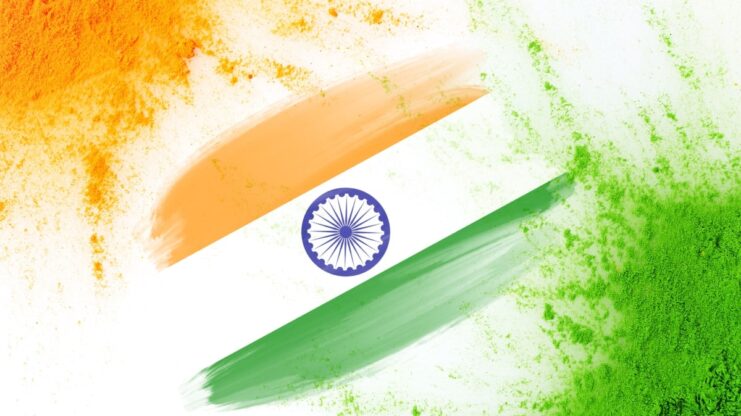
It is a horizontal tricolor in equal proportion to deep saffron on the top, white in the middle, and dark green at the bottom. It has a 24-spoke navy blue wheel in the center, which is known as Ashoka Chakra or Dharmachakra (Wheel of Law).
The Ashoka Chakra, taken from the Lion Capital at Sarnath, was initially adopted by the Indian National Congress during their struggle for freedom and was later included by Pt. Nehru in the Indian National Flag on 22nd July 1947.
The colors have important symbolism with Saffron denoting courage and selflessness, White symbolizing truth and purity, and Green representing faith and prosperity.
5. Mozambique Flag
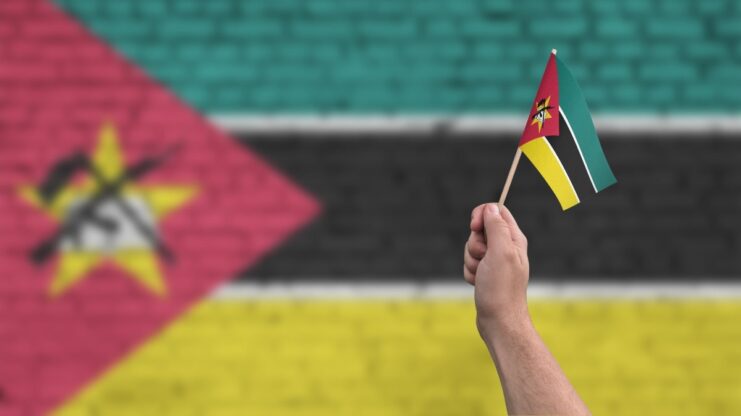
It is a unique and colorful representation of the country’s history and aspirations. Adopted on May 1, 1983, it features a horizontal tricolor of green, black, and yellow bands, with a red isosceles triangle on the hoist side. The triangle is charged with a yellow five-pointed star, in which is a black assault rifle that represents their fight for independence, a black hoe that represents the agriculture of the country, and an open white book that represents education.
The green stripe symbolizes the country’s agricultural resources, while the black stripe represents the African continent and the struggle for independence. The yellow stripe stands for the country’s minerals and natural resources, particularly gold. The yellow star represents the country’s struggle for independence, as well as international solidarity and support for socialism.
The design of Mozambique’s flag was heavily influenced by the country’s history of colonialism and its struggle for independence. The colors are reminiscent of the flag of the Mozambique Liberation Front (FRELIMO), which was the ruling party during the country’s independence struggle. The star on the flag is similar to the one on the FRELIMO emblem, while the cogwheel represents the country’s industrial aspirations and socialist ideals.
The flag of Mozambique is also notable for its unique shape. The isosceles triangle on the hoist side creates a distinctive appearance that sets it apart from many other national flags. This design was chosen to symbolize the country’s progress and forward momentum, as well as to reflect the shape of the country itself.
Overall, the flag of Mozambique is a powerful symbol of the country’s history, struggle for independence, and aspirations for the future. Its colorful and distinctive design reflects the rich cultural heritage and natural resources of the country, while also representing the ideals of progress, solidarity, and socialism.
Interesting Facts About Flags
They are a symbol of pride and identity for many countries around the world. While some follow the standard style of a rectangular flag with three horizontal stripes, other countries have created flags with more creative designs.
Let’s dive into some interesting facts about flags from around the world.
The Meaning Behind Flag Colors
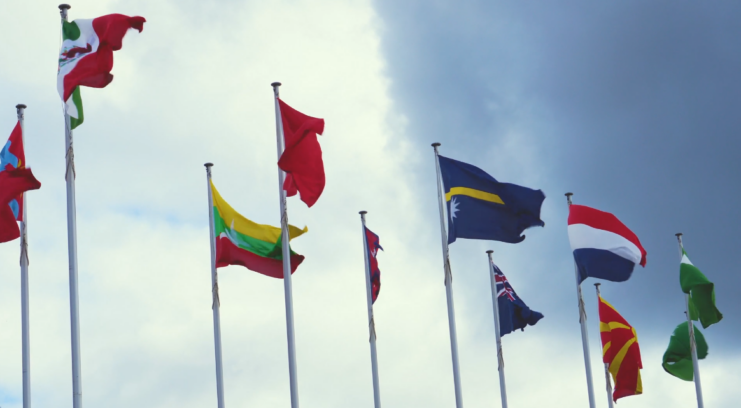
They are rich with symbolism and meaning and the colors used are often thoughtfully chosen. Generally speaking, there are three major groups of colors that have distinct meanings:
Primary shades of red, blue, and white can be found in most flags. Red typically stands for courage and blood, blue is used to represent loyalty, strength, and perseverance, while white symbolizes purity and virtue.
Additionally, you may find a combination of these primary colors to represent elements unique to the country’s culture, history, or landscape. For example, some countries may use a combination of red and white on their flag as a symbol of harmony or peace between people. Other countries such as Mexico believe green stands for hope while yellow represents potential wealth or prosperity.
Aside from those common symbolic meanings associated with the primary color palette on flags, you can also come across less predominant hues that are found in many flags around the world — like black which usually stands for courage; green which often alludes to life; orange which typically puts an emphasis on determination; purple which could represent justice; gold that could allude to glory; salmon pink denoting tradition; or even teal or sky blue which can stand for serenity. Ultimately these end up being tied to whatever personalities their nation holds dear: its values, history, faith, or beliefs as well as how it defines itself as a nation within a broader international community of nations alike.
The Significance of Flag Shapes
The shape of them is almost as important as the colors and designs within them. It’s a case of form following function — the iconic shape of each nation’s flag is deliberate. The most commonly flown flags tend to have rectangles at their base, but some of them have more unusual shapes. After all, there are many ways to capture a sense of national pride!
- Rectangular Flags: Most of them date back hundreds of years when standards known as pennons were used by knights in battle. The tradition has been passed down for generations and today it remains symbolically important across many nations.
- Triangular Flags: Known as burgees, they were first used in naval settings centuries ago and remain popular on ships to this day. They are also seen outside bodies of water; many nations use them to represent bilateral relationships or Christian beliefs related to the Holy Trinity.
- Square Flags: This uniquely shaped type originated with tribal associations around 1000 BC and they remain deeply symbolic today — notably with the Vatican City State’s flag which has been kept unchanged since 1825! The world-renowned Swiss flag celebrates Switzerland’s protection from invaders via its neutral positioning inside mountains and valleys, symbolizing strength against enemies from below or above ground.
- Unusual Shapes: A variety of countries have taken creative license with their national symbols over time — introducing unique shapes like hearts, animals, birds, and stars with the specific meaning behind them. These days there are so many interesting stories behind even the most recognizable flags that it’s easy to forget they had humble beginnings based on symbolism rather than design flair!
The History of Flag Designs
Their history and their designs are quite interesting. They often reflect the values, interests, and beliefs of a particular nation or culture. Their designs can be symbols of national pride, used as symbols in warfare, or simply used as a gesture to show respect to a certain group of people. Throughout their many centuries of use, flag designs have been constructed with various geometric shapes, different colors, and patterns, as well as unique symbolism.
Flag designs are often composed by individual countries and used as symbols to represent them at international events such as the Olympic Games or at conventions held by the United Nations. There have also been many organizations formed with the intention of creating unified flag designs that would serve to express unity between different cultural groups or nations. This has led to the formation of organizations such as the European Union and its associated “blue banner” design.
The most widely seen example in modern times is perhaps the iconic stars and stripes design that is featured on many American flags around the world. Other common traditional designs include those featuring crosses (often found in the representation of European nations) or shields (ancient symbols featured on banners). Sometimes they will include text such as mottos in addition to images which could offer a deeper understanding of why that nation or culture chose that particular design.
They are constantly evolving over time too; certain features may be phased out while others are introduced with new significance in tandem with global current events (such as new additions made surrounding World War II). In simpler forms though, they can just remain unchanged due to an almost timeless appeal – making them powerful identifiers throughout circles both large and small alike.
FAQs
What is the most popular color used in national flags?
The most popular color used is red, which is found in approximately 77% of all of them.
What is the significance of the colors used in the Mexican flag?
The green color represents hope and prosperity, the white represents purity and peace, and the red represents the blood of Mexican heroes.
What is the significance of the emblem in the Nepalese flag?
The emblem depicts the sun and the moon, which represents the hope that Nepal will last as long as the sun and the moon.
What is the significance of the colors used in the Indian flag?
The saffron color in it represents courage and sacrifice, the white represents purity and truth, and the green represents fertility and growth.
What is the significance of the colors used in the North Korean flag?
The red color in it represents revolutionary traditions, the white represents purity, and the blue represents the Korean people’s desire for peace and friendship with other nations.
What is the significance of the emblem in the Mexican flag?
The emblem depicts an eagle perched on a cactus while devouring a snake, which is a reference to a myth about the Aztec founding of Mexico City.
Conclusion
Ultimately, the best way to appreciate these strange and unusual flags is to raise discussion around them and ponder their subtle meanings. After all, even though they may seem odd, they represent something fundamental about a nation — its culture, history, and values. In this sense, strange as they are, these flags are no different than any other – they are symbols for our collective memory which connect people across boundaries and geography.

